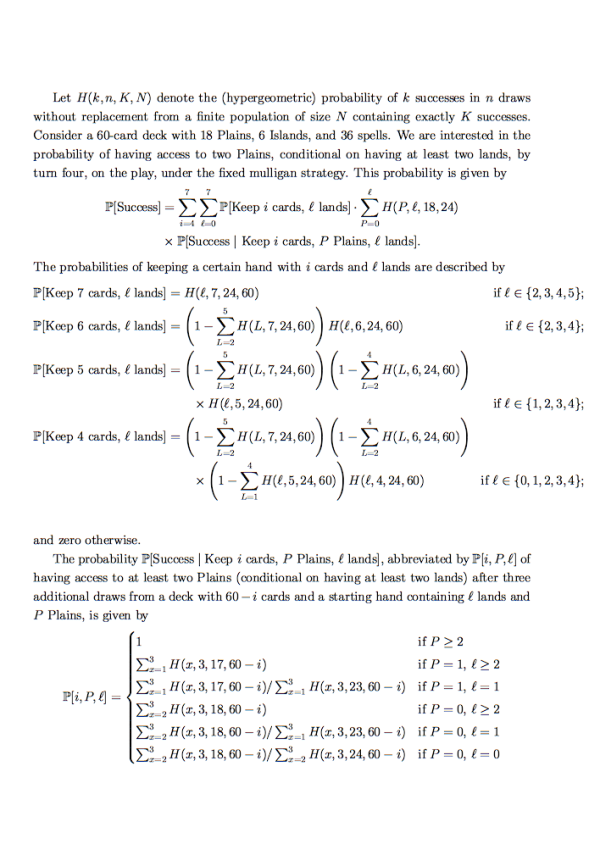When Friday night rolls around each week, thousands of Magic players go to their local game store (LGS) for Friday Night Magic. Many use this event to try a deck that put up good results at an SCG Tour, a Grand Prix or a Pro Tour event. Others use FNM as a chance to test their latest brew — one they’ve devised, to see how it stands up to the rest.
If you’re newer to Magic, building a new deck can be a daunting task. It seems fun to battle with something you’ve created, but the results don’t always line up with your aspirations. Today we’re going to go over a few ways to improve your basic deckbuilding skills so that the next time you sleeve up a brew, you’ll have a better chance against the competition.
Building a cohesive list
In the beginning stages of deckbuilding, one typically starts with all the so-called “best cards” they have at their disposal. While building an all out powerful deck of best cards is not always wrong, the concept can sometimes work against the end goal of winning a match. In short, new deck brewers often attempt to build a deck that is trying to do too many things, and in turn end up being mediocre at each.
Taking a somewhat exploratory approach to deckbuilding, I prefer to start with a 75 card deck, knowing that 15 of those cards will be placed in the sideboard (or deleted). Then I look at the whole list and decipher what the deck is trying to do (i.e. kill the opponent quickly, stall out until you play the game winning card on turn 15, trade back and forth until you gain an edge, etc.) Most decks struggle when they lack focus, so my first suggestion is to pick a style of deck and build on it; your options generally fall into one of four categories.
Types of Decks
- Aggro – killing quickly – lower land count and higher number of low Converted Mana Cost (CMC) creatures/spells
- Midrange – often trading resources until you run your opponent out of threats – medium land count, some disruption, creatures and removal, typically betting that you will survive the first few turns to play out more impactful cards starting on the third turn.
- Control – winning slowly based on card advantage and keeping the battlefield clear – higher land count, disruption, targeted and mass removal spells, a low numbers of creatures/win conditions, often using life total as a resource
- Combo – assembling the cards necessary to “go off” and win the game in a single turn – low to medium land count and high amount of deck manipulation (card draw, tutor effects, scrying)
- Once you have decided upon what style of deck you are building, it is time to remove the cards that are not helping you win that way.
For instance, you are often not going to play a 2/2 for two mana in a control deck, when that creature has no other abilities or benefits. It’s just not impactful (though crazier things have happened).
These decisions are not always easy to make because you may feel attached to a card because you like it or feel it is strong. For example, I played in a local PPTQ a few years ago during Theros/Khans Standard with a mono-red list. My entire list included nothing over 2 CMC except Stoke the Flames (which had convoke). I had cut Goblin Rabblemaster, which was seen as one of the best aggressive cards in the format. Doing this, however, allowed me to play fewer lands, which increased my chances of drawing threats and keeping up early-game pressure. I won the event.
Here is my decklist from that tournament:
Mono-Red Aggo
| Creatures (24) 3 Zurgo Bellstriker 4 Monastery Swiftspear 3 Lightning Berserker 2 Frenzied Goblin 4 Foundry Street Denizen 4 Firedrinker Satyr 4 Akroan Crusader | Lands (17) 17 Mountains Non-Creature Spells (19) 4 Titan's Strength 3 Hammerhand 4 Dragon Fodder 4 Stoke the Flames 4 Coordinated Assault Sideboard (15) 2 Scouring Sands 3 Roast 2 Magmatic Chasm 4 Eidolon of the Great Revel 1 Mardu Scout 3 Wild Slash |
Building a Mana Base
Developing a mana base is likely one of the most difficult parts of deck construction, and it’s something that every Magic: the Gathering player needs to do. Creating a mana base that allows you to cast your spells when they need to be cast is very difficult, especially when you have a multi-colored deck. One of the ways I use to help with this is to lay out your cards in piles based on converted casting cost (CMC) (similar to when you play solitaire) so you can see just the top of each card.
By doing this, you’ve created a visual representation of your Mana Curve (how many spells of each CMC you have). This will allow you to determine how many lands you may need to be playing in order to cast each spell. For instance, if you have spells that cost five or more mana in a standard deck, you will often need between 24-26 lands in your deck (depending on color disparity and/or deck manipulation).
Laying out the deck in such a fashion will also help you visualize what colors of mana you need earlier in the game versus later in the game. You may only have three to four cards that need blue mana, but if they they all cost 4 or more it may not be necessary to have untapped blue mana in the first couple of turns. If that is the case, you would want to create a mana base that has a high number of the color mana needed to cast the spells in the one, two and three CMC piles — Blue might not need quite as many because you’re still likely to draw them throughout the later turns of the game – even though at first glance it might seem like the opposite would be true.
There are numerous lands that produce multiple colors of mana (namely 2 different colors) which many people refer to as “dual lands”. Some of these lands come into play tapped and some have criteria, that if met, can come into play untapped. If you are playing a two color deck, having these dual lands allows you to have both colors quite often. In turn, it allows you to cast spells and actually play the game.
The big question that comes into play is, “how many of each land should a person have in a deck, to be able to get the results they are looking for, or cast spells on the turn they are meant to be cast?” The best way to figure that out is a simple math problem, also known as a hypergeometric distribution.

I’m joking, you don’t need to read that, but the image is intended to illustrate that it’s not simple. Frank Karsten, who writes for ChannelFireball.com, is a mathematician and often posts articles related to land counts and how to have a higher probability of the results you desire. Check out some of his posts if you don’t already follow him.
In short, creating an optimal mana base takes a lot of time. In many cases, it will involve simply testing a deck numerous times to decide if you need more of a color, more lands in general or if you can take lands out of a deck. A good rule of thumb is most deck will include anywhere from 17-26 lands, at least in the Standard Format. That being said, there is not a hard and fast rule to land count.
The Infamous Art of Building a Sideboard
As I indicated in the first part of this article, the first thing I do during deckbuilding is create a 75 card deck, knowing that 15 of the cards will be placed in the sideboard or deleted. How do I choose which cards will be cut from the maindeck, and which cards belong in the sideboard? Great question!
For all decks that I’ve put together, I do my best to make the main deck as streamlined as possible (focused on achieving my goals), while still including general answers to what my opponents might be doing. This allows me to avoid wasting space with card that have little impact in many situations (also known as dead cards). My sideboard will then be full of specific threats/answers I can use for specific opposing decks — once I know what my opponent is doing in games two or three. Again, this helps avoid dead cards in the main deck.
For instance, if I am playing my current brew — Standard UW Control, deck list posted at the end —, my main deck consists of four Torrential Gearhulk and no other creatures. When playing against opposing decks that contains black spells, I have to consider that, post-sideboard, they may bring in something to answer those rather large instant speed threats, such as a card like Dispossess. With that in mind, I generally sideboard out the gearhulks and sideboard in another creature threat that is hard to remove, Sphinx of the Final Word for example.
Now that I’ve removed four threats (win conditions), I need to supplement with alternate win conditions. That is why I may side in Approach of the Second Sun along with Pull From Tomorrow, which allows me to get to my win conditions.
When looking at your 75 card deck and figuring out which cards will be moved to the sideboard, remember that more often than not, your sideboard is meant to supplement your main deck and not completely change your deck. There are times that call for a sideboard to completely rework how a deck runs (known as a transitional sideboard), however, that is a topic for another time…..maybe.
The cards that go into your sideboard should be cards that improve upon cards already in the main deck, either because they are more efficient, relevant, or because you found yourself with dead cards in game one.
Conclusion
Deck building and brewing is not an easy feat for anyone, but it’s one of the things that makes playing this game fun. Being innovative and trying new ideas can be scary, but without allowing yourself to become vulnerable, you will also hold yourself back from becoming better. Testing your brew and discussing it with others can lead to helpful insight (i.e. what could could be improved or what adjustments need to be made). And of course, an important point to remember is that it takes time — you may not build an ultra-competitive deck on the first try — but sticking with it and making constant improvements will reward you with interesting, continuously improving matches and a better understanding of the game itself.
I hope this article helps you understand some of the more general concepts of deck building. So get out there and brew up a storm at your LGS.
** (Pre-Hour of Devastation) Standard UW Control list:
| Creatures (4) 4 Torrential Gearhulk Planeswalkers (1) 1 Jace, Unraveler of Secrets | Lands (25) 4 Prairie Stream 4 Irrigated Farmland 4 Port town 8 Island 5 Plains Spells (30) 4 Censor 2 Blessed Alliance 4 Immolating Glare 2 Horribly Awry 2 Negate 4 Disallow 2 Cast Out 4 Glimmer of Genius 3 Fumigate 1 Descend upon the Sinful 1 Approach of the Second Sun 1 Pull from Tomorrow Sideboard (15) 1 Sphinx of the Final Word 1 Linvala, the Preserver 3 Authority of the Consuls 1 Dispel 2 Declaration in Stone 2 Negate 1 Commit//Memory 2 Summary Dismissal 1 Pull from Tomorrow 1 Approach of the Second Sun |

1 comment